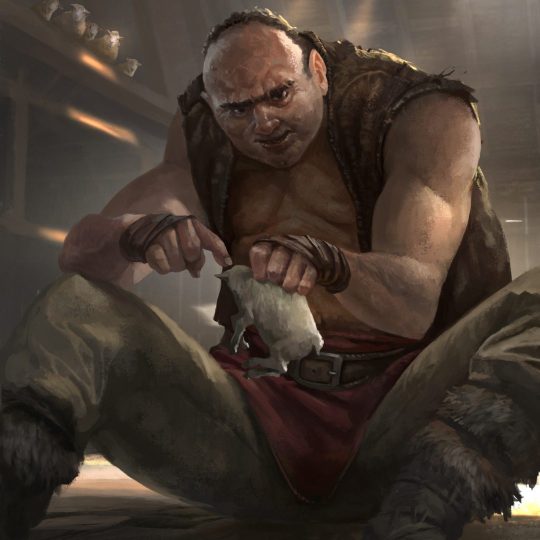
RPG Ideas — Technology
Welcome once again to the weekly newsletter. This week’s topic is technology, which we discussed in our weekly live chat. We hangout every Monday evening at 8 p.m. EST on Nerdarchy Live to talk about D&D, RPGs, gaming, life and whatever nerdy stuff comes up. Speaking of technology Vargarian Collective blends sci-fi technology with fantasy for Fifth Edition in an adventure for 4-6 characters of 5th-10th level along with a new playable race, four new magic items and 10 new creatures. You can get the Nerdarchy Newsletter delivered to your inbox each week, along with updates and info on how to game with Nerdarchy plus snag a FREE GIFT by signing up here. You can get the Nerdarchy Newsletter delivered to your inbox each week, along with updates and info on how to game with Nerdarchy plus snag a FREE GIFT by signing up here.
Nerdy News
Pierce the illusion of the weeks that were! The special mid-week newsletter following the end of our Mage Forge Kickstarter put us a little off track so enjoy this double-sized Nerdy News covering two weeks from the website and YouTube channel including new live chats with industry pros and creative folks and live game plays round out this week’s Nerdy News. Check it out here.
Delving Dave’s Dungeon
Technology can really be a thing to set the tone of your RPG campaign. Technology can also drastically alter how characters approach solving problems in a game. Playing a fantasy game allowing for black powder? Now overcoming an obstacle might involve blowing it up with science instead of magic. Playing a modern or sci-fi game? Solving a mystery might be done by Googling instead of good old fashioned investigation skills.
I’ve literally run RPGs set in modern times and showed players an image. They wanted to know if their characters could Google to try and find the places shown in the images. I did one better. I told them to Google and see what they came up with. They found the images I showed them because they were real places. The game proceeded from there. It was kind of cool because the players were doing the actual thing their characters were doing in the game. Talk about an immersive experience.
This is without getting into genre mashing. In my earlier days of gaming we played mostly D&D — so much so for a long time it was what we played exclusively. Back in those days I considered myself a bit of a fantasy purist and wouldn’t dream of adding more advanced technology into my D&D games.
At some point something changed. I started getting bored with doing everything the same for so long and started exploring other ideas with a new campaign setting I came up with called Shattered Realm. It started after the world blew up. The whole world was land masses floating in what I called an aether sea. Ships constructed with special wood could sail across the aether. There were also some steampunk elements incorporated. I went from it must be pure fantasy to flying ships and goblin zombies in steam powered armor constructed by gnomes.
Fast forward 20 years to the game I just started running called Under the Dome. Funny enough it’s another post apocalyptic world. The surface of the world has been ravished by chaos magic. The landscapes are weird inhospitable wastelands but pockets of civilization exist under magical technology domes designed to filter out or deflect away chaos magic. The technology level of the city is gaslight fantasy. Instead of running the city on steam or electricity it runs technology fueled by magic from the chaos magic running rampant outside the city.
As storms of this magic strike they leave behind chaos crystals that are harvested. These are then turned into a substance known as grind. Grind is controlled by five barons who rule the city and turn the harvested crystals into it’s refined form. Grind is used to power the dome, light the street lamps and power vehicles and weapons.
We are using the infernal war machines from Baldur’s Gate: Descent into Avernus. These vehicles aren’t powered by souls, but grind. A pinch of grind keeps your ride going for one day and there’s 16 pinches to a pound. Scavengers ride forth from the city on Devil’s Rides to collect the raw material. The group all started off having their own ride.
Session 1 started with a huge race around the city and session 2 will send the adventuring party out into the sea of blades to harvest raw grind crystals from a thri-kreen infested wound in the land that is bleeding the stuff. Sea of Blades are grasslands where the grass is tall as a man and sharp as a razor. This doesn’t seem to bother the thri-kreen through their carapaces.
Black powder weapons can also be found in this setting but instead of actually being black powder they use grind.
This setting was mostly inspired because I wanted the players to be able to be part of a motorcycle gang in a D&D game. I had to then imagine how this technology would work in the game. I really didn’t want to devour souls for them to get from place to place so I came up with grind and tied it to chaos storms which have featured heavily in our campaigns before. This one piece of technology kind spawned a whole campaign setting.
For anyone interested in the Race Rules I ran in the game we’ll dropping them over on our Patreon before the end of the month.
From Ted’s Head
Years ago I was a purist with my roleplaying games. Anything outside of fantasy was off the table. Ironically this was not the way I started. One Game Master from our group had run West End Games’ Star Wars RPG, Shadowrun and of course D&D. He might have run other games besides. I either do not remember playing them or was not a part. But for a couple of decades we played only D&D and there was nothing close to technology in our games.
After the release of Eberron and its technology mixed within D&D vibe and then playing fourth edition D&D there was a change. While our table liked 4E D&D it did not feel like D&D. Dabbling in other styles of games in college prepped the way for our table to leave D&D and play some superhero games.
Now I am playing a D&D campaign where we are a motorcycle gang in a post apocalyptic fantasy world and it is awesome. I eagerly look for more ways to add technology, steampunk and clockwork into my games. If you are not there, or never get there, it is okay. But if you are on the fence and considering adding these type of options into your game, take the plunge and embrace the atypical fantasy.
If you are looking to play an RPG with technology mixed into it then Numenera, or the Cypher System, is a great d20 based system with a lot of flexibility in the styles of games you can run. While it is a d20 system the flow and playstyle of the game is drastically different from games like D&D and Pathfinder. If you are looking for a gritty end-of-the-world sci-fi horror game please let me recommend Vast Grimm. You can check out Nerdarchist Dave in a Vast Grimm game over on the Infinite Black channel here.
As far as technology in D&D constructs, modrons, steam powered constructs and devices are a good starting point. Has chaos run so rampant on your world that modrons have invaded and are trying to fix the chaos? The mortals who happen to get in the way are just a small problem. Perhaps steam power has just become the norm and steam pipes are being installed all over the city. Life has become easier in some regards but there will always be complications. Warforged were introduced in Eberron as part of a vast war. How are sentient constructs created in your world? Were constructs spontaneously gaining sentience or were the gods involved in making this change?
From the Nerditor’s Desk
I grew up on a steady diet of both tabletop and video game RPGs and for me incorporating technology into a fantasy setting is old hat. Discovering a robot deep within an ancient ruin, a crashed spaceship in the fantasy wilderness, a powerful faction whose forces carry ray guns against their sword wielding enemies and the like feel right at home.
At the same time I’ve been a huge science fiction fan for just as long so RPGs with heavy themes of technology have always been part of my gaming habit too. And of course there’s always the most famous of futurist writer Arthur C. Clarke’s three laws to help bridge the gap whenever we need a reasonable explanation in our games.
“Any sufficiently advanced technology is indistinguishable from magic.” — one of Clarke’s Three Laws, along with, “When a distinguished but elderly scientist states that something is possible, they are almost certainly right. When they state that something is impossible, they are very probably wrong,” and, “The only way of discovering the limits of the possible is to venture a little way past them into the impossible.”
Unlike magic when it comes to technology the biggest benefit for RPG experiences is relatability. Even in scenarios featuring futuristic technology well beyond the scope of our modern day knowledge and capabilities I find players generally have an easier time wrapping their heads around these concepts — including myself. Teleportation, travel, communications and the like seem to feel more believable than commanding universal forces with some gestures, funny words and animal droppings.
Technology at any level — from fire and round wheels to disintegration rifles and interstellar spaceships — tends to create a more level playing field. A wizard who studies for years may develop abilities far more powerful than any average mortal may achieve. But slap a laser pistol in someone’s hand and all of a sudden they’re firing off energy blasts same as any learned mystic.
But technology can present challenges for a Game Master too. I’ve run many a game with technology levels at our own modern day or greater and players quickly begin to realize the extraordinary benefits at their disposal. In fact in my experience science fiction settings mitigate these challenges because without real world analogs the players don’t have as easy a time exploiting it for their gain.
On the other hand technology can create some amazing plot hooks for the same reasons it can be tricky to handle. The science fiction campaign I’ve been running the last couple of months takes place in our own solar system but 500 years in the future. Many of the hooks players express interest in stem from technological sources. A mysterious drone ship they tangled with, strange signals they’ve detected, discrete android networks and the like all captured their attention and drive the characters’ ambitions.
When it comes right down to it I prefer technology and science fiction over magic and fantasy because of the relatability I mentioned earlier. It’s fun to play around with technology concepts and explore the different directions they can take a story. Players understand technology in a way that’s impossible to replicate through magic even when the tech is far beyond our own reality and this is a very enjoyable space to explore in RPG experiences.
*Featured image — An unusual visitor to the heroes’ world needs help, but it puts the adventurers at odds with the Vargarians — cybernetic invaders from another dimension! Can the party find what they need at the Vargarian outpost in their world and escape without being assimilated into the Collective? Check out Vargarian Collective and find out here!









No Comments